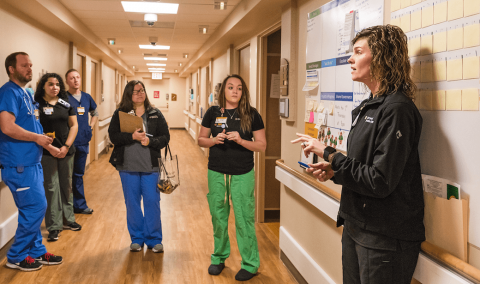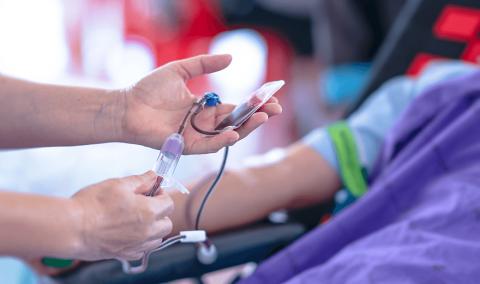At University of Missouri Health Care, we focus on patient safety by investigating, reporting and preventing medical errors. We use the latest medical evidence to help us meet national patient safety goals. We also apply lessons from other businesses and industries, such as the pilot training that has helped make air travel the safest form of transportation.
To keep our patients safe, we are continually at work developing new technologies. Educating our doctors, nurses and other health care providers, as well as patients, about patient safety is an ongoing commitment for everyone at MU Health Care.
Quality improvement innovation
MU Health Care is dedicated to enhancing the quality of patient care. One way we improve care is by following proven techniques based on the latest health care research. Another way we improve health care is by developing and implementing programs aimed at improving patient care in new ways.
Preventing infection
People can catch infections anywhere. That cold you caught at work last fall was an infection, and when your son needed antibiotics to treat that playground injury, that was an infection, too.
Patients seeking health care often have weakened immune systems or other medical conditions that make them especially vulnerable to infections. State-of-the-art heath care requires the use of many tools and techniques to improve and save lives, such as surgery, urinary catheters and ventilators to help patients breathe. However, every medical treatment carries a risk of complications or side effects. Fortunately, the risk of complications can be lowered and many infections can be prevented when health care professionals follow careful practices. Learn more about different infections and what we are doing to prevent them.
- Hand hygiene
- Clostridium difficile (C. diff) infections
- Methicillin-resistant Staphylococcus aureus (MRSA)
- Catheter-associated urinary tract infections (CAUTIs)
Hand hygiene
MU Health Care is continually working to improve our hand hygiene rates through numerous initiatives.
- Alcohol-based hand gels and hand-washing sinks are available throughout our hospitals and clinics.
- We monitor our staff to see how well they are doing with hand hygiene.
What can patients and families do to help?
We encourage all patients, family members and visitors to clean their hands often. Every hospital room has a hand-washing sink with soap and water and hand sanitizer dispensers are located throughout our hospitals and clinics.
How are we doing?
Over the past several years, our hand-hygiene rates have been approximately 95 percent. Our efforts to improve hand hygiene have included staff education, continuous monitoring by trained experts, and greater availability of hand-hygiene resources such as sanitizing gel.
While our hand-hygiene rate is among the highest reported rates of hand-hygiene compliance according the World Health Organization's "WHO Guidelines on Hand Hygiene in Health Care," we continue to work for higher levels of excellence.
Clostridium difficile (C. diff) infections
Clostridium difficile, often called C. diff by health care professionals, is a type of bacteria that causes diarrhea and other intestinal diseases. It usually does not make healthy people ill, but it can cause serious illness in older people or people with weakened immune systems, such as many health care patients. The germ is naturally occurring in the intestines of some people, but it can overwhelm a patient's body if the balance between good and bad bacteria in his or her intestines is disrupted, which can sometimes be caused by antibiotics. C. diff is a tough bacteria and can live outside the human body for long periods of time, so hospitals must use strict infection control measures to prevent hospital patients from becoming sickened by the bacteria.
What are we doing to prevent Clostridium difficile (C. diff) infections?
To prevent C. diff infections, doctors, nurses and other health care team members:
- Wash their hands with soap and water or clean their hands with an alcohol-based sanitizer before and after caring for every patient
- Only prescribe and give patients antibiotics when necessary
- Carefully clean all of our hospital rooms and medical equipment to remove C. diff germs
- Use ultraviolet lights to make sure all C. diff is killed after a patient with C. diff is discharged.
Additionally, all patients with C. diff are given a private room to avoid spreading the bacteria. When caring for patients with C. diff, caregivers wear gloves and a gown over their clothing.
What can patients do to help?
Patients and their families can also help to reduce the risk of C. diff infections. For more information, please read the CDC’s C. diff fact sheet
How are we doing?
MU Health Care has kept our infection rates low for C. difficile during the past several years by following recognized best practices such as those listed above.
Methicillin-resistant Staphylococcus aureus (MRSA)
Staphylococcus aureus, commonly known as Staph, is a common bacteria; about one out of three people carries this germ on his or her body. Staph can sometimes cause serious infections, especially in people with weakened immune systems, such as many health care patients. Staph can cause skin, wound or blood infections, or pneumonia. Most Staph infections can be treated with regular antibiotics. Some types of Staph bacteria, however, such as methicillin-resistant Staphylococcus aureus (MRSA), are resistant to treatment with many antibiotics.
What are we doing to reduce MRSA infections?
To prevent MRSA infections, doctors, nurses and other health care team members:
- Wash their hands with soap and water or clean their hands with an alcohol-based sanitizer before and after caring for every patient
- Carefully clean all of our hospital rooms and medical equipment with germ-killing antiseptic materials
What can patients do to help?
Patients and their families can also help to reduce the risk of MRSA infection. For more information, please read the CDC’s MRSA fact sheet.
How are we doing?
MU Health Care has succeeded in reducing our MRSA rates by carefully following the practices listed above. MU Health Care's health care-associated MRSA rates have steadily decreased during the past several years. Our infection rates are calculated by comparing the average number of infections for every 1,000 days patients are in our hospitals. MU Health Care's current rates of MRSA infection are less than 0.15 infections per 1,000 patient days. We attribute that success to following the best practices named above, especially strict adherence to guidelines called body-substance precautions.
Catheter-associated urinary tract infections (CAUTIs)
Catheter-associated urinary tract infections (CAUTIs) are the source of approximately 30 to 40 percent of all hospital-acquired infections. Any time a foreign object is placed in the body there is a risk of infection. MU Health Care has taken steps to reduce these infections by emphasizing multiple interventions.
What are we doing to reduce these infections?
We take many steps to reduce infections, including:
- Implementation of an electronic reminder system to emphasize the importance of removing urinary catheters as soon as possible. Nurses and physicians are asked to evaluate the need for urinary catheters before inserting them, when ordering them and twice daily.
- Use of hand hygiene and gloves prior to insertion and touching the urinary catheter
- Have trained, skilled individuals insert catheters
- Use alternatives to a urinary catheter whenever possible
- Take daily care of the catheter, including cleaning and maintaining unrestricted flow
- Have ongoing surveillance by champions on each unit to ensure indications are met
- Provide training for staff members who handle and insert catheters
- Use internal reporting to all units on rates of use of catheters and rates of infection
What can patients do to help?
For each day that a catheter is in the urinary tract, there is an increased risk of infection. Ask your care providers if there is really a need for the catheter and insist that it be removed as soon as possible.
How are we doing?
Since implementation of the set of interventions, we have reduced our use of catheters and have seen a 40 percent drop in our rate of infection.



























